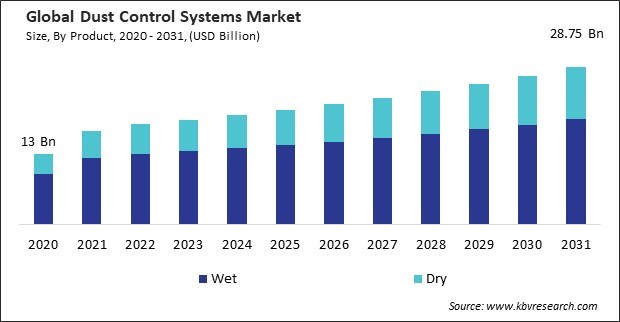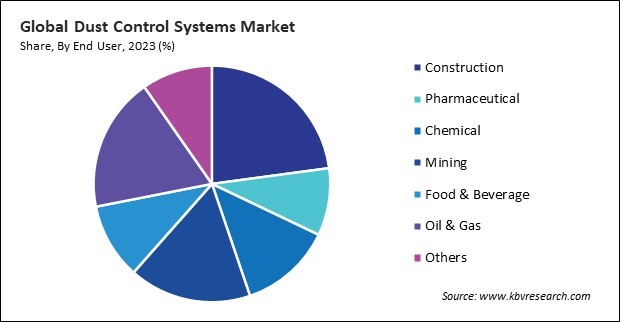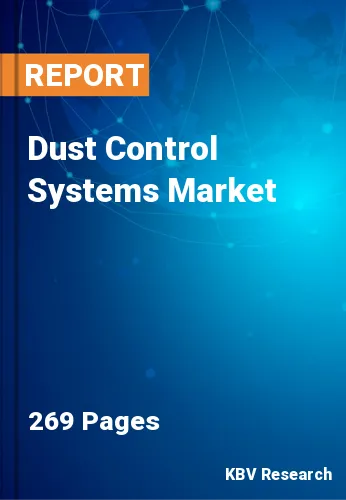“Global Dust Control Systems Market to reach a market value of USD 28.8 Billion by 2031 growing at a CAGR of 5.3%”
The Global Dust Control Systems Market size is expected to reach $28.75 billion by 2031, rising at a market growth of 5.3% CAGR during the forecast period.
The expansion of industrial activities across sectors such as manufacturing, mining, metalworking, pharmaceuticals, and food processing has spurred the demand for these systems, including bag dust collectors. Consequently, the bag dust collectors segment would acquire nearly 30% of the total market share by 2031. Bag dust collectors offer an effective solution for capturing and containing dust particles generated during material handling, grinding, machining, and other industrial operations.

Regulatory authorities across the globe are tightening the reins on dust emissions to combat air pollution and protect public health and the environment. These systems are instrumental in reducing the dispersion of harmful particulate matter into the atmosphere, thereby mitigating environmental pollution and safeguarding air quality. Hence, these aspects can boost the demand in the market. Additionally, Mounting evidence highlights the adverse health consequences of prolonged exposure to airborne dust particles, causing a heightened sense of concern among workers, employers, and regulatory authorities regarding respiratory health risks. Moreover, the escalating health concerns have prompted organizations to prioritize adopting advanced systems to mitigate respiratory health risks among workers. Thus, these aspects can pose lucrative growth prospects for the market.
However, these systems typically require specialized equipment such as dust collectors, air scrubbers, ventilation systems, and filtration devices. Moreover, these systems incur ongoing maintenance and operating expenses beyond the initial investment, including regular servicing, filter replacements, energy consumption, and water usage. Thus, these factors can hamper the growth of the market.
Based on end user, the market is divided into construction, oil & gas, pharmaceutical, mining, chemical, food & beverage, and others. The oil and gas segment procured a 20% revenue share in the market in 2023. The industry has experienced significant expansion, with increased exploration, drilling, production, and transportation activities to meet global energy demand. As oil and gas operations expand into new territories, including remote and environmentally sensitive areas, there is a heightened need for effective dust control measures to mitigate the environmental impact of dust emissions. Therefore, these aspects can boost the demand in the segment.

Based on product, the market is bifurcated into wet and dry. In 2023, the dry segment garnered a 30% revenue share in the market. Ongoing advancements in dry dust control technologies have enhanced the effectiveness and efficiency of dust mitigation solutions. Innovations such as high-efficiency filtration systems, electrostatic precipitators, and modular dust collectors offer improved performance, reliability, and versatility in capturing and containing airborne dust particles. Thus, owing to these factors, there will be enhanced demand in the segment.
Free Valuable Insights: Global Dust Control Systems Market size to reach USD 28.8 Billion by 2031
By region, the market is segmented into North America, Europe, Asia Pacific, and LAMEA. The Asia Pacific segment procured 40% revenue share in the market in 2023. Government initiatives aimed at promoting environmental sustainability, air quality improvement, and pollution control are driving the adoption of these systems in the Asia Pacific region. Increasing awareness about the environmental and health impacts of air pollution, coupled with corporate responsibility initiatives, is driving the adoption of these systems among businesses in the Asia Pacific region. These aspects will pose lucrative growth prospects for the segment.
| Report Attribute | Details |
|---|---|
| Market size value in 2023 | USD 19.2 Billion |
| Market size forecast in 2031 | USD 28.8 Billion |
| Base Year | 2023 |
| Historical Period | 2020 to 2022 |
| Forecast Period | 2024 to 2031 |
| Revenue Growth Rate | CAGR of 5.3% from 2024 to 2031 |
| Number of Pages | 269 |
| Number of Tables | 470 |
| Report coverage | Market Trends, Revenue Estimation and Forecast, Segmentation Analysis, Regional and Country Breakdown, Porter’s 5 Forces Analysis, Company Profiling, Companies Strategic Developments, SWOT Analysis, Winning Imperatives |
| Segments covered | Product, End User, Region |
| Country scope |
|
| Companies Included | Donaldson Company, Inc., Nederman Holding AB, Spraying Systems Co., Absolent Air Care Group AB (Mexab Industri AB), BossTek, Inc., EmiControls Srl (TechnoAlpin SpA), Beltran Technologies, Inc., Camfil AB, Sly, Inc. and Parker Hannifin Corporation |
By Product
By End User
By Geography
This Market size is expected to reach $28.75 billion by 2031.
Increasing stringency of environmental regulations and standards are driving the Market in coming years, however, High initial investment costs and capital-intensive nature restraints the growth of the Market.
Donaldson Company, Inc., Nederman Holding AB, Spraying Systems Co., Absolent Air Care Group AB (Mexab Industri AB), BossTek, Inc., EmiControls Srl (TechnoAlpin SpA), Beltran Technologies, Inc., Camfil AB, Sly, Inc. and Parker Hannifin Corporation
The expected CAGR of this Market is 5.3% from 2024 to 2031.
The Wet segment led the Market by Product in 2023; there by, achieving a market value of $19.2 billion by 2031.
The Asia Pacific region dominated the Market by Region in 2023, and would continue to be a dominant market till 2031; there by, achieving a market value of $11.3 billion by 2031.
Our team of dedicated experts can provide you with attractive expansion opportunities for your business.

 Drivers
Drivers
 Restraints
Restraints
 Opportunities
Opportunities
 Challenges
Challenges
